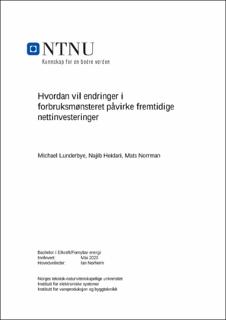| dc.description.abstract | I dette prosjektet blir AMS data analysert for å danne et bilde av strømnettets forløp over 2019, for 8 nettstasjoner i et lokalt nett.
Det blir analysert reelt effektuttak og samtidighetsfaktorer, samt sannsynlige kapasitets- og drifts utfordringer. Data fra AMS-målere basert på kundenivå og aggregert for nettstasjon, blir benyttet for å fremstille effekttopper og beregninger av samtidigheter i fase 1. Dette har blitt utført i Microsoft Excel.
I fase 2 blir det utført lastflytanalyse i NetBas for å illustrere økt effektuttak i antall elbilladere på strømnettet. Videre simuleres det solcelle produksjon både med og uten elbilladere, for å se hvordan dette tolereres av nettet. Simuleringer illustrerer gitte tilfeller, deriblant nåværende situasjon og såkalte «The Worst Case Scenarios». I tillegg blir det også undersøkt om det er andre konsekvenser som elbiler påfører nettet, i forhold til effektflyt og spenningsfall.
Dette resulterer i eksisterende og fremtidig status for de forskjellige nettområdene, og fremtidige utfordringer.
Oppgaven konkluderer med at dersom strømnettet skal opprettholde drift i de kommende årene og unngå driftsutfordringer, så må forbruksmønsteret blir styrt slik at ny effekt ikke kommer samtidig med eksisterende effekttopper. Alternativt må nettet oppgraderes, blant annet til tre fase tilkoblinger i tilknytningspunkter med en-fasekobling. | |
| dc.description.abstract | This project analyses AMS data to create an overview of the power grid situation of the year 2019, for eight grid areas in a local network.
Analysis is performed for real effect consumption and simultaneity factors, as well as probable capacity- and operational challenges. Data from AMS-measurers based on consumer level and aggregated values for grid stations, is used to visualize top effects and to calculate the simultaneity factors in phase 1. This has been accomplished with Microsoft Excel.
In phase 2, load flow analysis has been done in NetBas, to illustrate effect consumption of a select number of electrical car chargers in the power grid. As well as solar cell power production with and without the electrical car chargers, to investigate how the power grid tolerates it.
The simulations include various scenarios, among which are the existing cases and the Worst-case scenarios. The objective of integrating electrical vehicles in the simulation, is to see the impact on the local power grid. In addition, other ways that the electrical car chargers can cause consequences on the grid, is examined, in relation to effect flow and voltage loss in nodes.
This results in existing and future status for the grid areas, and future grid challenges.
The thesis concludes that, if the power grid is to maintain functionality in the coming years and avoid operational challenges, then the consumption patterns requires measures of control, so that the new effects do not coincide with existing top effects. Alternatively, the grid needs to be upgraded, among other things to three phase connections in nodes with single phase connections. | |
